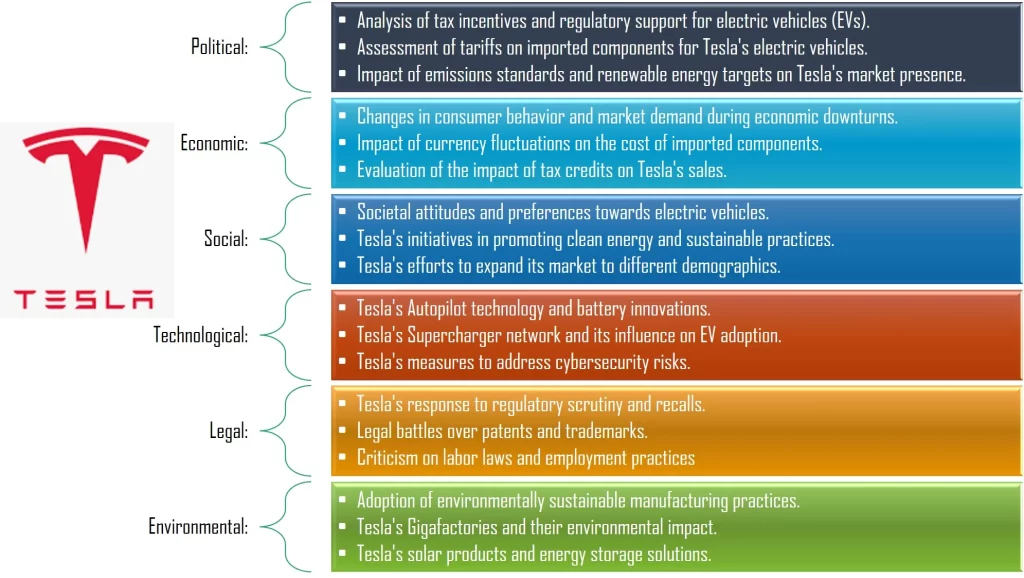
Below is a sample PESTLE analysis essay on Tesla Inc. This example is intended to help students write better business PESTLE analysis essays.
Tesla PESTLE Analysis Essay
PESTLE Analysis Essay Outline: Tesla Inc.
Here is the outline for this sample PESTLE analysis essay:
- Introduction
- Brief introduction to Tesla, emphasizing its prominence in the automotive and clean energy sectors.
- Importance of conducting a PESTLE analysis for Tesla’s strategic evaluation.
- Purpose of the essay: to analyze the external macro-environmental factors impacting Tesla.
- Political Factors
- Government Regulations
- Exploration of government regulations affecting Tesla’s manufacturing and distribution processes.
- Example: Analysis of tax incentives and regulatory support for electric vehicles (EVs).
- International Trade Policies
- Examination of how global trade policies impact Tesla’s supply chain and export/import activities.
- Example: Assessment of tariffs on imported components for Tesla’s electric vehicles.
- Environmental Regulations
- Discussion on environmental regulations affecting Tesla’s operations, especially in the context of clean energy.
- Example: Impact of emissions standards and renewable energy targets on Tesla’s market presence.
- Economic Factors
- Consumer Spending on Electric Vehicles
- Analysis of economic conditions influencing consumer spending on electric vehicles.
- Example: Changes in consumer behavior and market demand during economic downturns.
- Currency Exchange Rates
- Examination of how currency exchange rates impact Tesla’s international operations.
- Example: Impact of currency fluctuations on the cost of imported components.
- Economic Incentives
- Exploration of economic incentives that influence Tesla’s business, such as government subsidies for EVs.
- Example: Evaluation of the impact of tax credits on Tesla’s sales.
- Sociocultural Factors
- Consumer Preferences
- Analysis of societal attitudes and preferences towards electric vehicles.
- Example: Consideration of cultural factors influencing the adoption of sustainable transportation.
- Social Responsibility
- Examination of Tesla’s social responsibility initiatives and their impact.
- Example: Assessment of Tesla’s initiatives in promoting clean energy and sustainable practices.
- Demographic Trends
- Discussion on demographic trends influencing Tesla’s target market.
- Example: Analysis of Tesla’s efforts to expand its market to different demographics.
- Technological Factors
- Innovations in Electric Vehicles
- Analysis of technological advancements in electric vehicles that impact Tesla’s competitive position.
- Example: Evaluation of Tesla’s Autopilot technology and battery innovations.
- Charging Infrastructure
- Examination of technological factors related to charging infrastructure for electric vehicles.
- Example: Analysis of Tesla’s Supercharger network and its influence on EV adoption.
- Cybersecurity Concerns
- Discussion on technological challenges, especially in the context of cybersecurity for connected vehicles.
- Example: Consideration of Tesla’s measures to address cybersecurity risks.
- Legal Factors
- Regulatory Compliance
- Exploration of legal considerations related to Tesla’s compliance with industry standards and regulations.
- Example: Assessment of Tesla’s response to regulatory scrutiny and recalls.
- Intellectual Property Protection
- Analysis of legal factors related to Tesla’s intellectual property protection.
- Example: Evaluation of Tesla’s legal battles over patents and trademarks.
- Labor Laws and Employment Practices
- Discussion on legal considerations related to labor laws and employment practices.
- Example: Examination of labor-related challenges or controversies involving Tesla.
- Environmental Factors
- Sustainable Manufacturing Practices
- Analysis of Tesla’s efforts to adopt environmentally sustainable manufacturing practices.
- Example: Assessment of Tesla’s Gigafactories and their environmental impact.
- Clean Energy Initiatives
- Exploration of Tesla’s clean energy initiatives and their influence on environmental sustainability.
- Example: Analysis of Tesla’s solar products and energy storage solutions.
- Conclusion
- Summarization of key findings from the PESTLE analysis.
- Implications of external factors for Tesla’s strategic decision-making.
- Overall assessment of Tesla’s resilience and adaptability in the face of macro-environmental changes.

